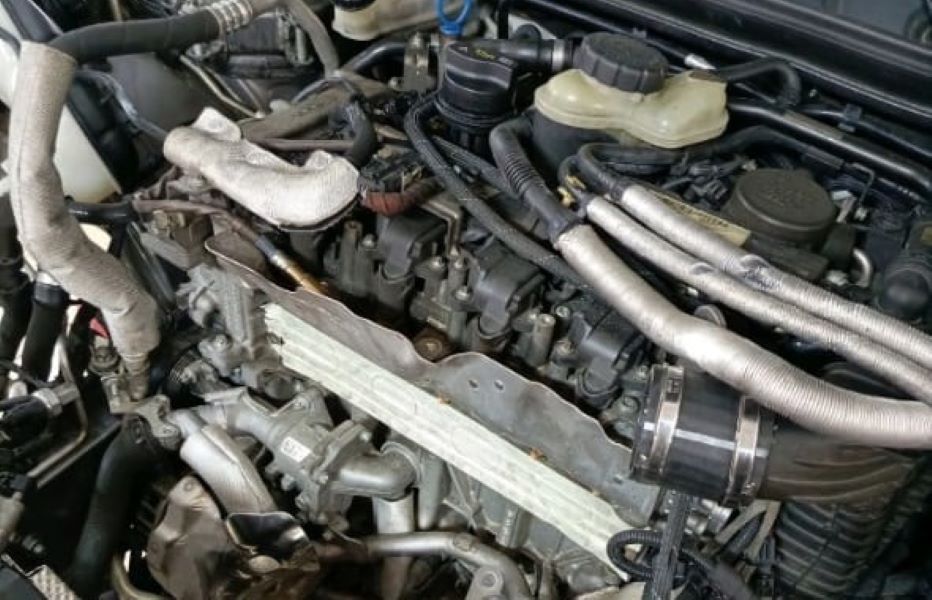Table of Contents
Mercedes Coolant Leak: Diagnosing and Fixing the Issue in a Mercedes-Benz CLA 45 AMG
A Mercedes-Benz CLA 45 AMG equipped with the M133 engine recently came into our workshop with a coolant-related complaint. Coolant leaks are one of the most common problems across all vehicle types, but when it comes to a performance-oriented engine like the M133, the consequences can be severe if not fixed quickly.
A Mercedes coolant leak doesn’t just mean a mess on the garage floor it can cause overheating, engine damage, and even turbocharger failure if ignored.
This case study breaks down the symptoms, diagnosis, repair process, and final outcome for a CLA 45 AMG suffering from a coolant leak.
Vehicle Overview
- – Model: Mercedes-Benz CLA 45 AMG
- – Engine: M133 2.0L Turbocharged Inline-4
- – Customer Complaint: Noticeable coolant leak and low coolant warning

Step 1: Initial Inspection
The customer reported:
- – Small puddles of coolant under the vehicle after parking.
- – Dashboard warning light for low coolant.
A quick inspection of the reservoir and surrounding hoses didn’t reveal obvious signs of leakage. This is common in hidden leaks, which often only show up under pressure.
Diagnosis Tool Used: Coolant Pressure Tester
By pressurizing the system, I confirmed the leak originated from the water pump, which is tucked away beneath the exhaust manifold and turbocharger a notoriously difficult location in the M133 engine.

Step 2: Accessing the Water Pump
Accessing the water pump in this engine requires major disassembly:
- 1. Turbocharger Removal: Since the turbocharger sits directly above the pump, all coolant and oil lines were disconnected carefully.
- 2. Exhaust Manifold Disassembly: Removing the manifold opened space to reach the buried water pump.
This stage is delicate: damaging turbo or exhaust components could add thousands in additional repair costs.


Step 3: Replacing the Faulty Water Pump
Once the area was cleared, the water pump was removed and inspected. Wear and seal failure confirmed it as the root cause of the coolant leak.
Repair Actions Taken:
- – Installed a new OEM Mercedes-Benz water pump.
- – Replaced all necessary gaskets and seals to ensure future reliability.
- – Reassembled turbocharger and exhaust manifold with careful torque procedures.


Step 4: Post-Repair Testing
After installation, multiple tests ensured the repair was successful:
- 1 Pressure Test: Confirmed the system held pressure with no leaks.
- 2 Bleeding the Cooling System: Removed trapped air to prevent overheating later.
- 3 Road Test: Vehicle was driven under both city and highway conditions.
Result: The Mercedes coolant leak was eliminated, and the cooling system operated as designed.
Why Water Pump Leaks Are Common on the M133 Engine
The M133 engine in the CLA 45 AMG is a high-performance unit that runs hot under load. Water pumps endure extreme heat cycling, and over time:
- – Plastic components and seals weaken.
- – Constant pressure changes stress the pump housing.
- – Location beneath the turbo accelerates wear due to added heat exposure.
Regular inspections during service intervals can catch early signs of seepage before they become major leaks.
Conclusion
This case study demonstrates the importance of promptly addressing a Mercedes coolant leak. In our CLA 45 AMG example, the faulty water pump was identified, replaced, and the system restored to full function.
Ignoring such a leak could have easily led to engine overheating, turbocharger failure, or costly repairs. With systematic diagnostics and OEM parts, the vehicle was returned to the customer in peak condition.
More Mercedes Cooling System Resources
Want to explore more causes, symptoms, and repair tips for coolant leaks, overheating, and contamination?
Learn more about Mercedes cooling system faults in our full Cooling System Guide.
FAQs About Mercedes Coolant Leaks
1. What are the common symptoms of a coolant leak in a Mercedes CLA 45 AMG?
- – Low coolant warning light
- – Puddles under the vehicle
- – Engine running hotter than usual
2. Can I drive my Mercedes if it has a coolant leak?
It’s not recommended. Driving with a coolant leak can lead to overheating and severe engine damage.
3. How much does it cost to fix a water pump leak on a CLA 45 AMG?
Depending on labor rates and part quality, the cost ranges from $800 to $1,500.
4. What type of coolant should be used in a Mercedes-Benz CLA 45 AMG?
Always use Mercedes-Benz approved coolant (MB 325.0/325.5) for proper system performance.
5. How can I prevent future coolant leaks?
Regular servicing, coolant inspections, and timely water pump replacement are the best preventive measures.
Mercedes Coolant Leak: Symptoms, Causes, and Fixes
| Symptom | Possible Cause | Recommended Fix |
|---|---|---|
| Low coolant warning on dashboard | Coolant leak from water pump | Replace faulty water pump with OEM Mercedes part |
| Puddles of coolant under the vehicle | Cracked hose or failed gasket/seal | Inspect hoses and gaskets, replace as needed |
| Engine overheating or running hot | Air trapped in cooling system | Bleed system properly after repair |
| Sweet smell inside/outside the car | Coolant evaporating from leak point | Perform pressure test to locate hidden leak |
| Coolant loss with no visible leak | Internal leak (e.g., head gasket issue) | Advanced diagnostics; inspect oil/coolant mix |
Author
Written by: Mercedes Expert
Automotive Technical Trainer & Mercedes-Benz Diagnostic Specialist
With years of hands-on experience repairing and diagnosing Mercedes-Benz vehicles, specializes in case-study-based troubleshooting guides that blend workshop accuracy with educational clarity.
— Salim, Mercedes Expert
Independent specialist in Mercedes-Benz diagnostics, CAN Bus analysis, troubleshooting case studies, and EV systems.







Leave a Reply